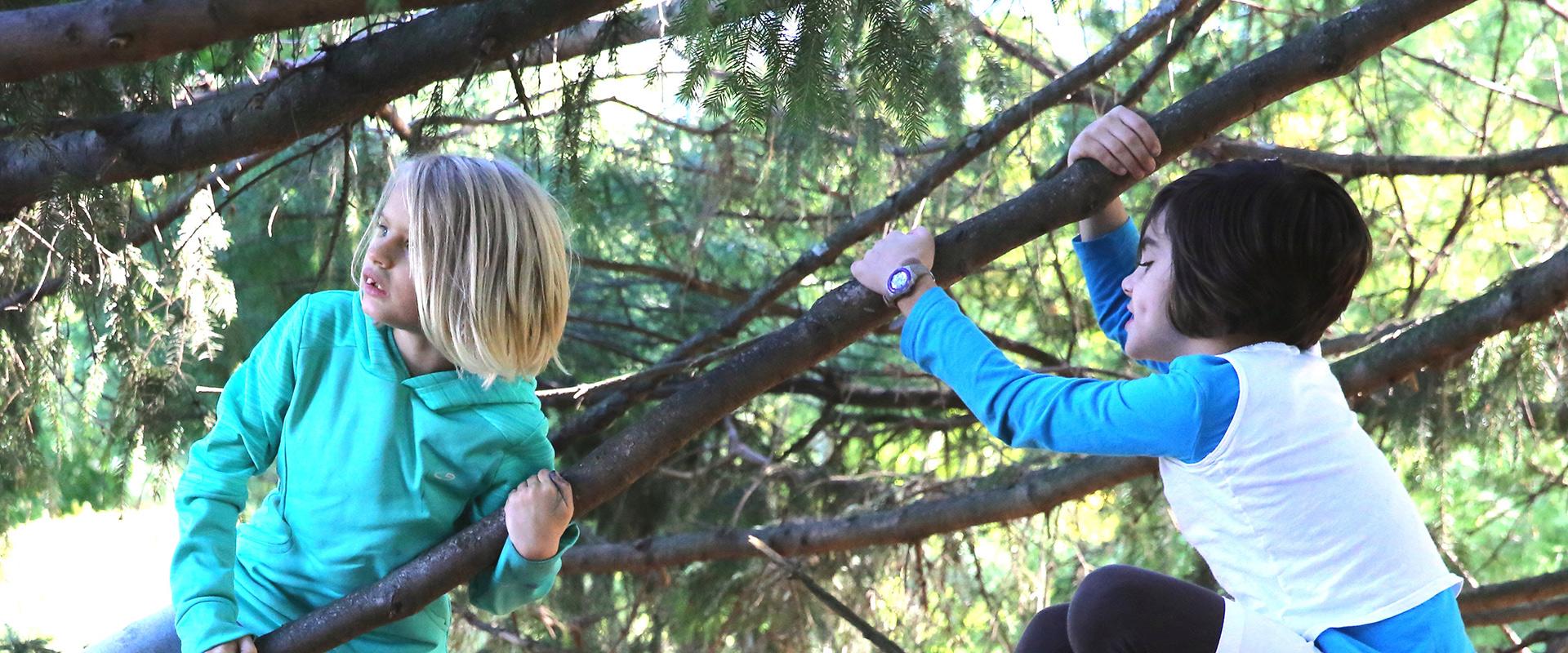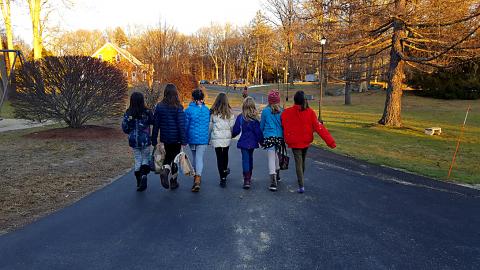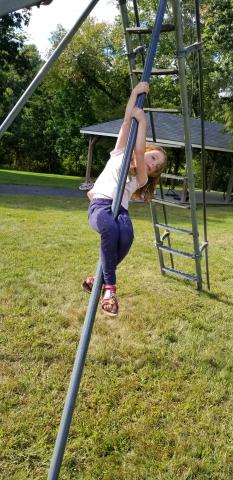One of the objections most frequently raised against Sudbury Valley School as an appropriate educational environment for children growing up in contemporary America is that the school, in focusing on self-knowledge, promotes the development of narcissistic adults who lack a sense of community. Sudbury Valley’s philosophy is seen as glorifying the individual at the expense of the broader society, to the detriment of the latter. This criticism is voiced despite the obvious sense of community that every observer of the school in action has noted, and despite the insistence of the school that it will grant a diploma only to students who have made a convincing case for the proposition that they are ready to be responsible members of the community at large.
This objection has such wide currency that one soon realizes that it reflects a deeper conflict within our culture. We are living in an age that has renounced the absolute dominance of the group over the individual – a dominance that in the past has all but negated the value of the single person – while at the same time exhibiting deep dissatisfaction with an ethos that elevates individual desires over all else – an elevation that has led to fearful displays of brutality and callousness by individuals towards their fellow humans. This apparent conflict of values seems irreconcilable, even though we know that only through their reconciliation can the human race hope to survive.
It is my contention, to be elaborated in this essay, that the conflict is illusory, and stems from an imperfect understanding of the relationship between the individual and society. The essential components of a proper explication of that relationship were developed in ancient times, in the two great civilizations that joined together to form the warp and woof of Western culture. The ancient Israelites worked with a world view that somehow embraced, simultaneously, the concept of man created in the image of God – about as lofty an exaltation of the individual as one can imagine – and the concept of the absolute supremacy of Israelite culture as a way of life for all people. The ancient Greeks explored the philosophical implications of the concept of community more deeply than any people had before them, while at the same time proclaiming the motto “Know Thyself” as the loftiest goal attainable by the human spirit. How these two disparate ancient cultures, on whose reservoirs of wisdom we still draw today, managed to work with this apparent dichotomy seems impossible to ascertain, until one realizes the full implications of each of its components.
The best place to start is through an understanding of the idea of “self”. Each person is born as a separate individual, possessed of internal systems with which to engage the outside world and to process the information received from that world. In order to become an independent organism capable of action, the child must learn how to create a coherent picture of his environment, and to fashion workable responses both to his internal demands and to the demands made upon him by his environment.1 The process of fashioning meaningful representations of reality is referred to as “model building”, and it comprises the entire set of activities, interactions, and thought processes that go into the incredibly complex task each person must undergo in order to possess within himself a picture of the world that is his version of reality.
The details of the model-building process are scarcely understood today, although the process as a whole can be observed everywhere, simply by looking carefully and patiently at the people around us as they go on with their daily lives. For it is an unending process, continually evolving as a person goes on through life, always visible – but seldom more transparent than with children, and even more so with younger children. There is no way to avoid this process and to remain alive. Everyone, whatever their social condition, class, religion, status, mood, intelligence, or talent, must continuously build and revise their internal models of reality in order to go on living, in order to go on interfacing with the world.
Even though the specific mechanisms of model-building are not known, it is certainly possible to point to some of the more important gross features of this activity. Perhaps the most significant one is what I shall call “the miracle of similarity”. Each human being is a separate and independent entity. Each has his own brain, his own body, his own senses, his own genetic makeup, his own inherited traits and predispositions. Each builds his own models, based on billions and trillions of separate inputs, components, interactions, calculations, etc. Yet, somehow, by some incredible and as-yet-unanalyzed mechanism, the models of reality ultimately developed by the overwhelming majority of adults turn out to be similar enough to each other in structure and in a huge number of minute details that these separate adults turn out to be able to communicate with each other and work effectively not only as individuals but as members of an organized group. Indeed, so pervasive is this miracle of similarity, that the human race has been said to have a natural tendency towards group formation, and man has been called a social animal by almost all observers of the human condition.
The miracle of similarity does not happen all at once. It is a phenomenon that is not at all true of infants, and in many respects is not true of very young children. In fact, one of the marks of maturation is the degree to which each child’s personal model of the world attains some similarity to the models of other children, and of adults, who surround that child.
We are now approaching the heart of the matter. The very essence of the human condition is the apartness of each person, the individuality of each human being, his uniqueness, his inherent worth – that, above all, is what religions have meant by man created in the image of God. At the same time, it is through the development of each person’s understanding of the world around him that the individual creates his ties to that world, and to the other people who inhabit it. The two processes work together, enhancing each other. The more advanced one is in his own personal process of model-building, the more developed is his sense of relationship to the total culture around him. Community Man, the social animal, is a direct product of the actualization of the full potential of Individual Man, the model-builder.
How does this happen? Part of the answer is known. We know that people learn how to interact with the purely physical part of their surroundings by a painstaking series of trial-and-error operations, based on an increasingly complex analysis of the results of their successive actions. This is how, as children, we develop ways to deal with hot and cold objects, with hard and soft objects, with bright and dark objects, etc. And it is how, as adults, we develop new methods of dealing with new and unfamiliar physical surroundings when we encounter them.
The physical environment, however, is only a part of the world surrounding a person. Other people are also important components of that world, not only as isolated islands of existence, but as active players in the environment, affecting the environment and also the person within it. So it becomes an essential component of the survival of every individual, from earliest childhood on, to figure out how to interact with, and how to affect the behavior of, the other individuals who surround him. To do this, each person must become an intuitive genius in psychology and sociology. He must create models of human behavior just as he creates models of the mechanical behavior of the physical universe around him. And in the course of doing this, he inevitably must seek somehow to understand other people’s world-models, in order to anticipate and deal with their behavior – and also, in order to use their model-building capacities as an additional resource to be tapped in his own search for a world model.
Thus, in learning to build effective models of reality, each individual uses to the greatest extent possible the model-building talents of everyone else he encounters. The rest of humanity becomes, for each developing person, a group of what we call “role models”, to learn from and to use in ways that can be integrated into that person’s being. The miracle of similarity somehow assures, without external intervention, that for the most part in most places at most times there will be many people in existence who have enough features of their world-models in common to act in concert in some of their daily activities. It is that concerted activity, however extensive or limited, that forms the fabric of social living.
We are now ready to address the central proposition on which Sudbury Valley School is based. First, however, it is worth noting a clear trend in Western thought. For many centuries, if not millennia, it has been recognized that the greatest progress in attaining an understanding of the physical universe is made when the people investigating it have the maximum freedom to explore and to build imaginative, creative new theories that are unhampered by external restrictions. Freedom of thought is the hallmark of good science and good philosophy; dogma and doctrine are widely held to be the enemy of progress in science. The reason for this is that the more and varied the models of reality are, the more likely it is that effective models will be found to give people a way of dealing with the physical world. The essential components here are not only complete freedom for each person to build models to his heart’s content, but also maximum availability to each person of the fruits of everyone else’s labor. Therefore, communication among scientists is as important as the individual labor of each scientist. At the root of this conviction is the notion that if people are given freedom to choose, and to learn from trial-and-error experiences, they will ultimately come up with better results than the ones they started with.
This same proposition, applied to human interactions, is what underlies Sudbury Valley’s approach. It is our belief that the greater the freedom allowed each child to build their own models of reality, and the less the interference from the outside, the greater the likelihood that each child will use a broad range of role models from which to construct his own particular model of human behavior; and the greater the likelihood that he, along with the others around him who enjoy the same freedom, will achieve models of reality that maximize the potential of cooperation in the search for better models. In other words, it is our belief that an environment that allows the greatest possible measure of latitude in the activity of developing an integrated sense of self for each student will at the same time provide the most fertile ground for developing a sense of cooperation and commonality among all persons in that student’s community, and ultimately in the world as a whole.
This approach does not glorify the individual at the expense of society. On the contrary, it recognizes the individual as the building block of society, and focuses on the process by which an individual creates his own model of social interaction. It is through each person’s understanding of himself and his world model that he obtains an understanding of other people, their models, and the necessity to interact with them successfully in order to survive. The more profound each person’s comprehension of his own world model is, the deeper the insight he has into the mechanisms through which he must seek to cooperate with his fellow man.
The end product of a Sudbury Valley School education, if not interfered with by other external forces that deflect the student from its full realization, is a person who has become adept at building and revising models of reality, based on all the inputs that he gets from the physical world around him, and from the people he encounters and their models. Insofar as he is unique, precious, free, and whole, he is indeed created “in the image of God”. Insofar as he has integrated his reality into those of his fellow humans, he is indeed a social animal.
Such a person has a peculiar mix of commitment and detachment that is the hallmark of the contemporary hero. On the one hand, he knows that whatever model he is working with is an evolving one. He is therefore free of static dogma, and of any need to proclaim his current model as the ultimate true model of reality. He has the inner peace and confidence to face the world every day with an imperfect model, knowing that he has the ability and skill to fashion such revisions as his evolving experience may suggest to him.
On the other hand, he knows that his inner strength and peace has come from, and depends critically on, the freedom he has enjoyed to interact with the world and people around him. He knows that this freedom makes him strong and whole at any given point in his life, and is essential to his continued existence as a whole person with an integrated world model. He sees the protection of this freedom, for himself and for his fellow human beings, as critical to his very life, and as what makes it worthwhile to continue to live. He cannot tolerate restrictions on this freedom, nor can he restrict another person’s freedom and be true to himself. Such a person, uncommitted though he may be to the ultimate validity of any particular world view, must, to survive, be committed to the maintenance of freedom and human tolerance at all costs, if life is to be worth living. Such a person, free of final commitment to any particular ideology, is firmly committed to maintain a working society of free individuals.
Sudbury Valley School is based on the notion that free individuals with a highly developed sense of themselves will be the best guarantors of a peaceful, cooperative society of people with a deep sense of mutual responsibility towards each other’s welfare. Our school is the modern embodiment of the ancient idea that those people who truly know themselves will be most likely to create an enlightened culture.2
SoundCloud artwork by Greer Gleason
ENDNOTES
1. I am constrained by the complexity of the argument in this essay to make the simplest possible use of pronouns; otherwise, the reader is in danger of losing the thread of the argument because of cumbersome usage. Therefore, although use of the forms he/she, his/her, him/her, him/herself, etc. has become fairly widespread, or avoided through the introduction of plurals or of noun forms, I beg the reader’s indulgence in accepting, in this essay, the more traditional male pronoun form as representing either gender.
2. The ideas I have set forth in this essay have been turning over in my mind for many years, but they formed themselves into a coherent whole as the result of my recent reading of the remarkable volume The Martyr’s Conviction, by Eugene Weiner and Anita Weiner (Scholar’s Press; Atlanta, GA), 1990; Brown University Judaic Studies No. 203, to which I owe a great debt of gratitude for providing the missing pieces in my own current model.
Copyright © Sudbury Valley School Press ®



